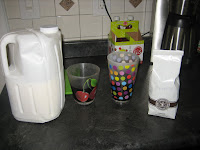Pharma’s quest to unlock the molecular mystery of coffee
It’s
fascinating to consider how coffee is de-caffeinated. The general idea is that
the coffee beans are steamed and then rinsed repeatedly with a solvent to
extract the caffeine, while leaving the other components intact.
What happens
to the caffeine? It turns out that when coffee companies extract caffeine from
coffee beans, they send the caffeine to pharmaceutical companies. Pharma
companies then take the caffeine and use it as part of analgesic medications,
such as Excedrin and other OTC medications.
The magic of caffeine
Coffee
contains lots of things besides caffeine, which is just one of the hundreds of
bioactive ingredients found in coffee, in addition to antioxidants, chlorogenic
acids, melonoidins and other components.
All of the
components of coffee combined confer numerous benefits to those who consume it,
such as a decreased risk of diabetes, Parkinson’s disease, certain types of
cancer and depression, among other things. However, as the world’s most
consumed psychostimulant in the world, coffee owes its astounding popularity to
its caffeine.
Targeted adenosine activity
In terms of
its mode of action, also known as MOA, coffee is a nonselective antagonist of
several adenosine receptors—A1, A2, A2b and A3---meaning it blocks the activity
of these receptors, resulting in specific reactions in the central nervous system
and the cardiovascular system.
Caffeine’s
MOA is compelling because of its immediate and obvious benefits---increased
energy and alertness and the ability to perform almost any activity, whether it’s
productive or not, better. It all comes down to adenosine blockade.
Harnessing adenosine without side effects
For more
than 20 years, pharma companies have been researching potential therapeutic
applications of selective adenosine modulation (both blocking and enhancing
various adenosine receptors). Researchers have found that effectively
manipulating adenosine receptors could help treat the molecular damage and
inflammation associated with Alzheimer’s disease, Parkinson’s disease and
spinal cord injury.
However, developing
effective targeted adenosine modulator therapies has been challenging, because
of the ubiquity of adenosine receptors and the problem of side effects. The goal is to not only identify druggable adenosine targets, but to develop a drug that hits that target without systemic side effects. In
fact, there is only one FDA-approved selective adenosine agonist---Lexiscan
(regadenison), which is marketed by Astellas.
The first and only adenosine agonist
Lexiscan is
approved for use in cardiac stress imaging in patients who are unable to use a
treadmill or stationary bike. For those patients, IV infusion of Lexiscan increases
blood flow to the heart for diagnostic purposes.
Companies with adenosine-related products
Three
companies---Astellas, Fujisawa and Bedford Labs, manufacture a pure adenosine
injection, which is used clinically to help normalize certain abnormal heart
rhythms. Meanwhile, Adenosine Therapeutics has been at the forefront of
adenosine therapeutic research, with mixed results. The company has been in
business since 1999 and has struggled financially, continuing to look for
financing or a partner to help it bring its phase 3 cardiac stress agent,
Stedivase, to market.
At the
moment, coffee remains the most reliable way to manipulate adenosine receptors and
achieve physical and psychological (not to mention) social benefits. Drink up.




Comments